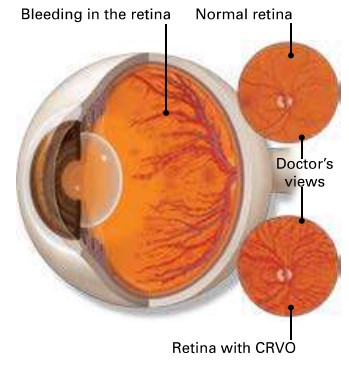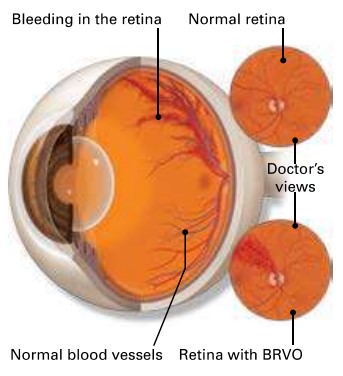What is a retinal vein occlusion?
Your retina has veins and other blood vessels that carry blood. When a vein in your retina is blocked (occluded), it is called a retinal vein occlusion. This can be caused by a blood clot. Or it can happen when a larger blood vessel presses down on the vein.
With retinal vein occlusion, weaker blood vessels may end up carrying more blood. They might start to leak, which causes the macula to swell or thicken. This is called macular edema, and it leads to blurry vision or vision loss.
With an occlusion, abnormal blood vessels can grow in your iris (colored part of your eye). They can also grow in other areas at the front of your eye. This growth can cause painful pressure in the eye.
There are two types of retinal vein occlusion:
- CRVO (central retinal vein occlusion). This is when your eye’s main vein is blocked.
- BRVO (branch retinal vein occlusion). This is when small blood vessels attached to the eye’s main vein are blocked.


Eye Words to Know
Retina: Layer of cells lining the back wall inside the eye. This layer senses light and sends signals to the brain so you can see.
Macula: Small but important area in the center of the retina. You need the macula to see fine details in objects in front of you.
Vitreous: Clear, gel-like substance that fills the inside of your eye. The vitreous helps the eye maintain its shape and also transmits light to the retina.
Floaters: Tiny clumps of cells or other material inside the vitreous. These look like small specks, strings or clouds moving in your field of vision.
What causes retinal vein occlusion?
- obesity
- diabetes
- glaucoma (increased pressure inside the eye)
- high blood pressure
- diseases related to blood vessels (vascular disease)
What are symptoms of retinal vein occlusion?
Symptoms can include:
- blurry or less vision
- noticing a lot of floaters in your field of vision
- pain inside your eye if new blood vessels grow and cause high pressure in your eye
It is very important to call an ophthalmologist right away if you have any symptoms. He or she will check your eyes thoroughly and talk about treatment options. You may become blind if you do not have treatment for retinal vein occlusion.
How is retinal vein occlusion diagnosed?
Your ophthalmologist will put drops in your eye to dilate (widen) your pupil. This allows him or her to look through a special lens at the inside of your eye.
Your doctor may do fluorescein angiography to see what is happening with your retina. Yellow dye (called fluorescein) is injected into a vein, usually in your arm. The dye travels through your blood vessels. A special camera takes photos of the retina as the dye travels throughout its blood vessels. This shows if any blood vessels are blocked or leaking fluid.
Optical coherence tomography (OCT) is another way to look closely at the retina. A machine scans the retina and provides very detailed images of its thickness. This helps your doctor find and measure swelling of your macula.
What are symptoms of retinal vein occlusion?
Symptoms can include:
- lurry or less vision
- noticing a lot of floaters in your field of vision
- pain inside your eye if new blood vessels grow and cause high pressure in your eye
How is retinal vein occlusion treated?
Your ophthalmologist will treat you based on what he or she sees in your eye. Treatment may include:
- Medicine. A drug is given by injections
(shots) inside the eye. It helps to reduce swelling of the macula. This helps to slow vision loss and perhaps improve vision. - Laser surgery. Your ophthalmologist may use a laser to shrink certain blood vessels in your retina. This is so that they won’t bleed, and to prevent them from growing back. Laser surgery may help slow vision loss and perhaps improve vision.
- Managing your health. Diabetes, glaucoma, high blood pressure or other health problems can lead to retinal vein occlusion. Taking care of your health can keep you from getting this serious eye problem. Your doctor may talk with you about the best ways to manage your health.
Summary
Retinal vein occlusion is when a vein in your retina is blocked. This causes blurry vision or vision loss. It is treated with medication injections or laser surgery. Taking care of health problems like diabetes and high blood pressure can help prevent this eye condition.
If you have any questions about your eyes or your vision, speak with your ophthalmologist. He or she is committed to protecting your sight.
Get more information about retinal vein occlusion from EyeSmart-provided by the American Academy of Ophthalmology-at aao.org/retinal-vein-occlusion-link.
